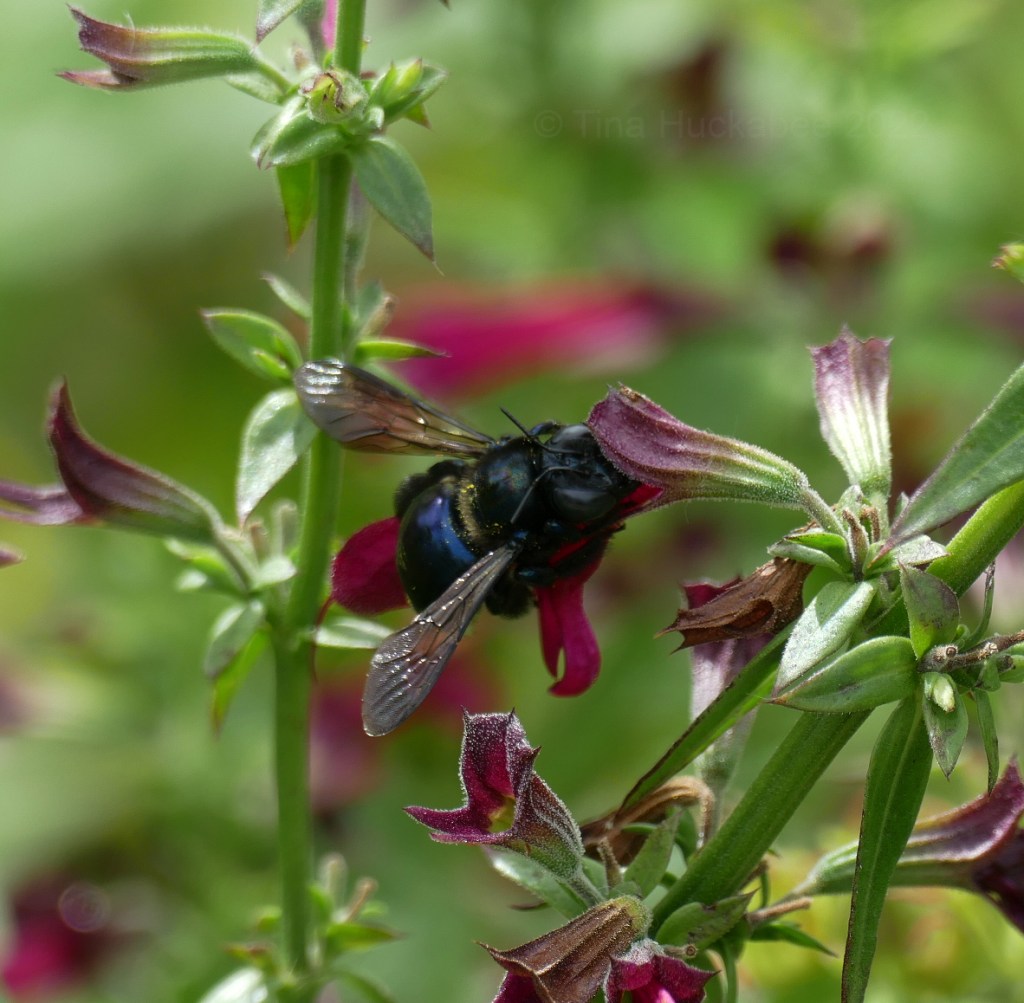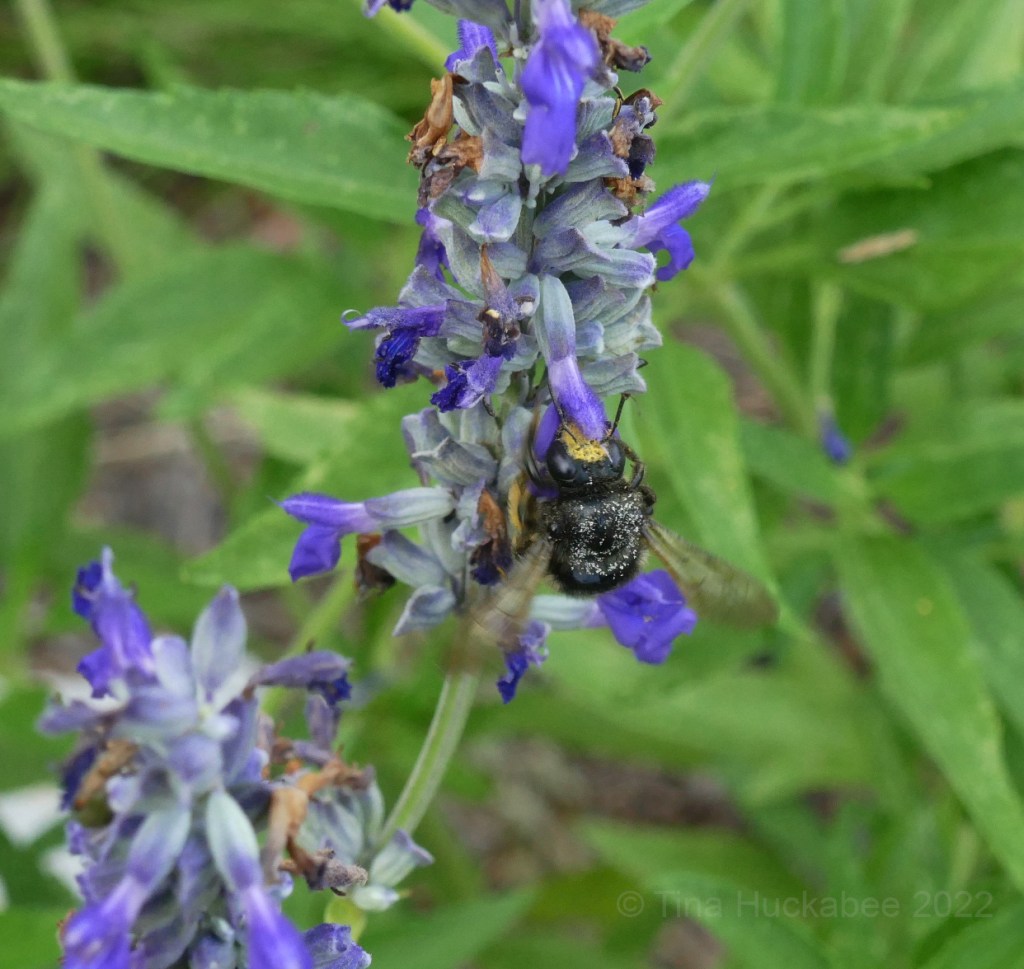Bees are busy pollinating the summer garden, but like the rest of us, they need rest. Foraging is hard work! This Horsefly-like Carpenter bee, Xylocopa tabaniformis, chose a pretty pink bougainvillea bract as its preferred napping spot.

I watched it for some time as I puttered in the garden and it didn’t move. I’ve seen bees “sleep” on flowers in the past, usually on petals or atop leaves. I’m sure they rest in other places too, but it’s likely that those spots are more private, less noticed by the perspiring gardener. I checked the plant after puttering and the bee had moved on.
This Southern Carpenter bee, Xylocopa micans, participating in nectar robbing, is poised to poke its proboscis into the bloom of a Big Red Sage, Salvia penstemonoides.

Nectar robbing or nectar stealing is a way that various insects, bats, birds, and mammals consume nectar without the benefit to the plant of pollination. In the case of bees, they typically bite or poke a hole in the petal tissue, then sip the nectar, bypassing the parts of the flower where pollination happens. Flowers can be damaged by the robbing, thus preventing further visits from pollinators. As well, some pollinators also recognize when a bloom has been robbed of its nectar, so they move on to other nectar-filled flowers, the robbed flower missing out on pollination. For for various reasons, nectar robbing isn’t generally considered harmful for plants or an ecosystem as a whole, but is simply part of the functional tapestry of a diverse natural space.
Carpenter bees nectar rob because they’re such big bees they can’t fit into certain blooms. Generally, the blooms that bigger bees rob have slender, tubular corollas. This same Southern Carpenter bee is head-and-proboscis-deep into the base of the Big Red sage bloom, sipping the sweet stuff available. There’s no way that big body could nestle in the bloom.

Sometimes, a robber is sprinkled with pollen, perhaps due to buzz pollination. Buzz pollination happens when certain bees vibrate their strong thoracic muscles, vibrating, or sonicating, the pollen grains from flowers’ anthers. During foraging, this Horsefly-like Carpenter bee might have buzzed pollinated on a different flower, its back carrying sprinkles from the loosened pollen onward through the garden. The bee is too big to crawl into this bloom, a Henry Duelberg sage, Salvia farinacea, so stealing is the way to go.

Of course, there are those who pollinate the old-fashioned way, crawling all over a bloom, collecting pollen as they go! This native bee, perhaps a Mining bee, Andrenidae, or a Plasterer bee, Colletidae, enthusiastically worked the flower of a Texas thistle, Cirsium texanum.

Pollinating or robbing, it’s a busy time in the summer garden, especially for those who live in and rely on its bounty. After a hard day in the garden, sleep is bliss.

Do you think a Sonicare toothbrush could be used for sonicating?
LikeLike
Possibly, though it might get toothpaste all over the place.
LikeLike
I have seen bees nectar rob but never knew the term for it.
LikeLike
I’ve mostly witnessed the big bees doing it, but I guess others might, as well.
LikeLiked by 1 person
After learning about carpenter bees shortcutting the pollination process, I was astounded to see a honeybee doing the same. Luckily, that isn’t a common practice!
LikeLike
Wow–I’ve never seen that. I’ll keep an eye on my honeys to see if they’re involved in nectar theft!
LikeLike
Bees and other pollinators are fascinating to watch, indeed! I have my computer set up near a large window, so it’s fun to watch the pollinators on the plants outdoors next to me.
LikeLike
They are wonderful to watch. Getting decent photos of them, well that’s a different story. 🙂
LikeLike
Those are some great shots lady!
We’ve noted bees robbing nectar even out of larger blossoms that hadn’t fully opened yet. “Patience, pollinators…let the flower have a minute”. I’ve wondered if that is a learned behavior or in response to demand outstripping resources or if it becomes habitual for some bees. That goes against the idea of all bees being so industrious, doesn’t it!
LikeLike
Thanks, Deb. I was happy with these photos. I’ve been trying to get some good shots of hummingbirds and bumble bees and the photographic fairies just aren’t with me right now.
I’ve also seen the carpenter bees hit up the not-quite-ready blooms. Patience, indeed!
LikeLike
Nature balances itself so it is not a surprise that nectar robbing is not terribly hamring to the plants. And the buzz pollination might be one way Nature has allowed for the robbing to have less of an impact. Just a guess.
LikeLike
Yes, in a healthy environment, there’s generally plenty for all, at least most of the time. Tell that to the hummingbirds chasing each other all over the place for dominance!
LikeLiked by 1 person
Interesting! Love that colorful bougainvillea.
LikeLike
The bougainvilleas are great summer ‘wows’ of color, that’s for sure.
LikeLiked by 1 person
I’ve tended to associate buzz pollination with plants in the Solanum genus; are there other genera where it’s a common occurrence? It’s such a clever strategy, and pretty important for the plants, too. I didn’t realize that nectar robbing is so common, either. More cleverness on the part of the bees! In the grand scheme of things, I can’t imagine that the nectar robbing is much of a problem for the plants. It surely was happening a century or two ago as well; nature balances itself out.
I wonder if anyone’s done a study on nectar robbing in cultivars, as opposed to straight species. I wonder if all the tweaking of color and form also affects the value of the plants for pollinators.
LikeLike